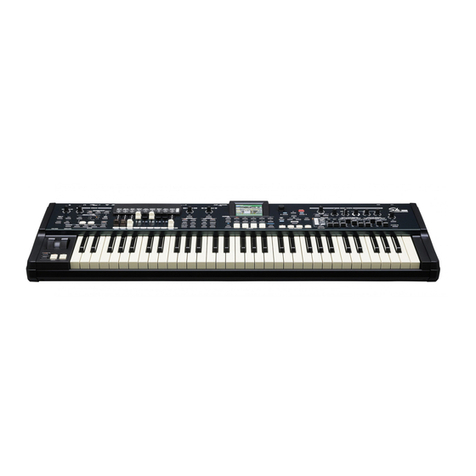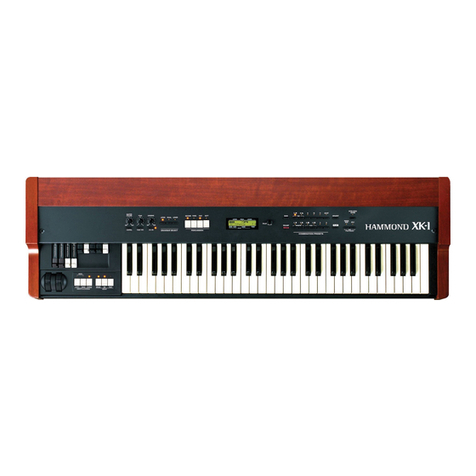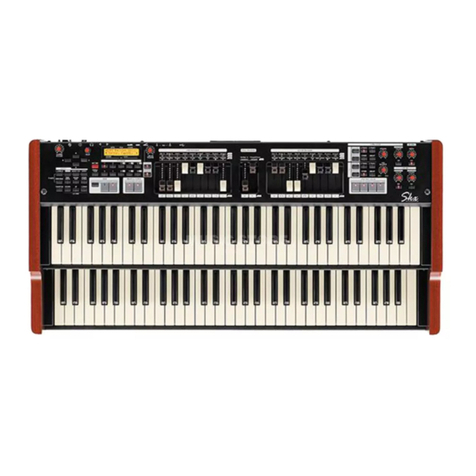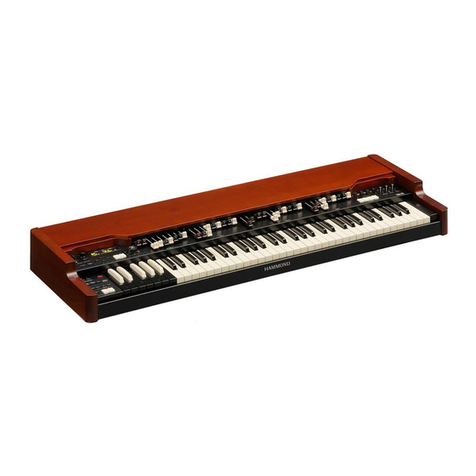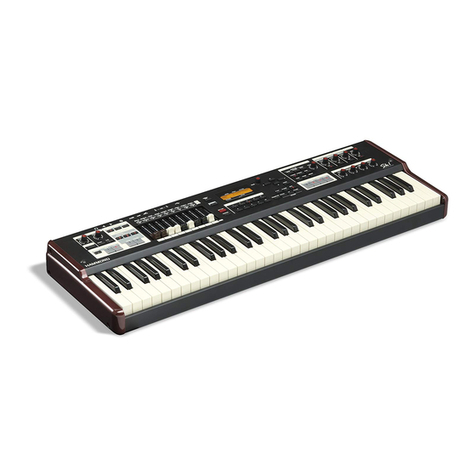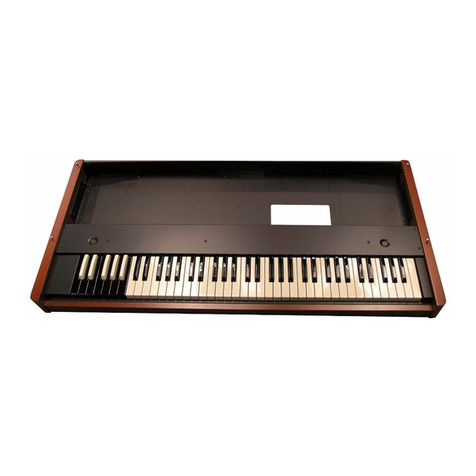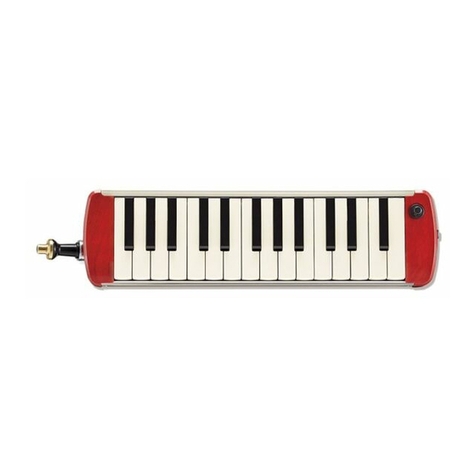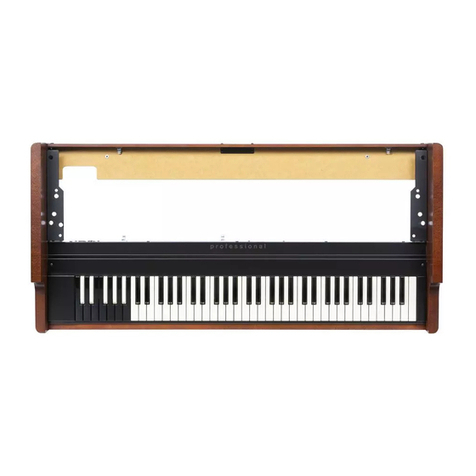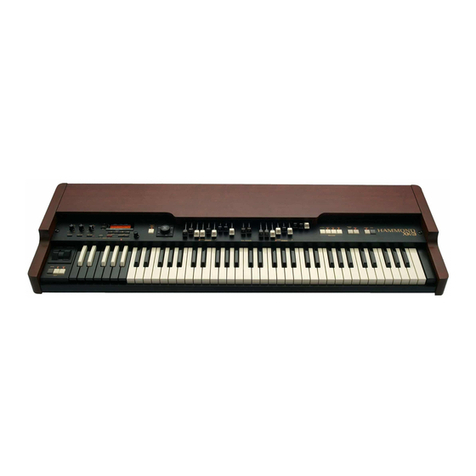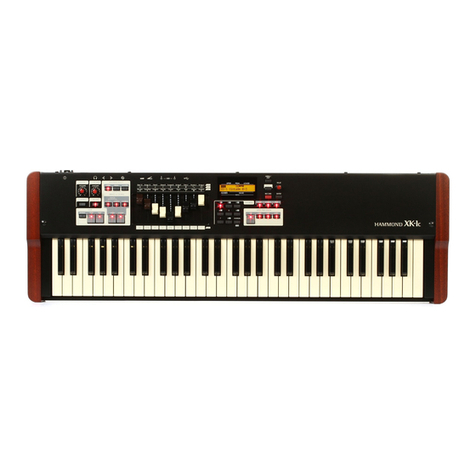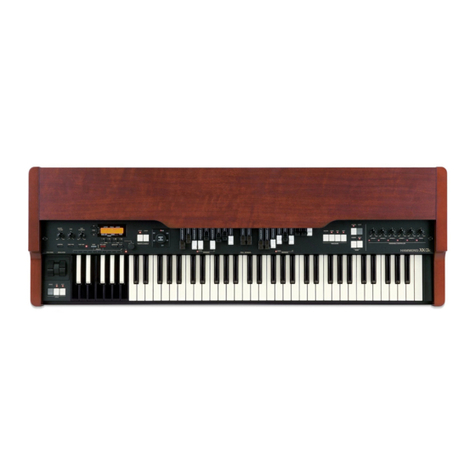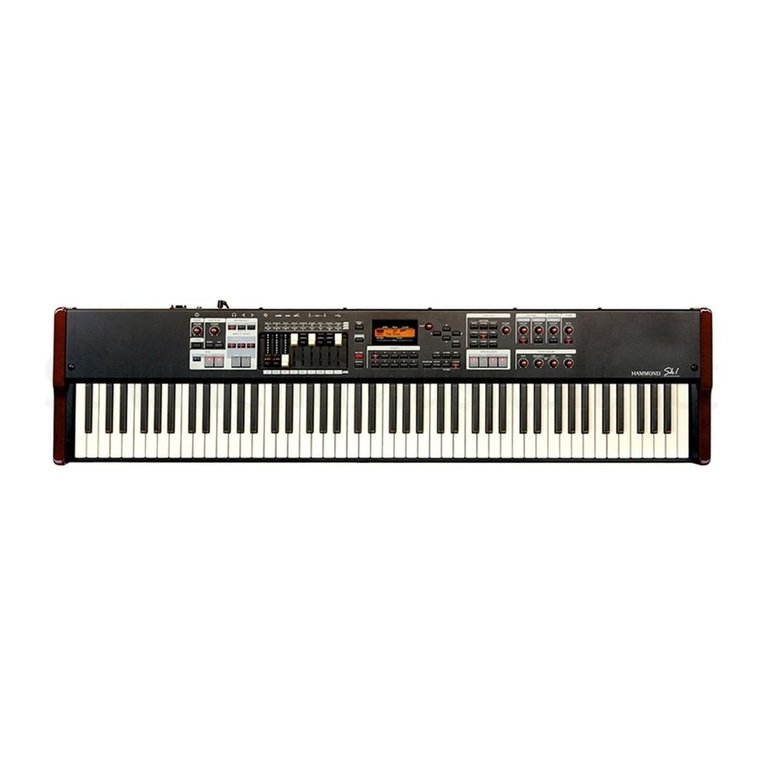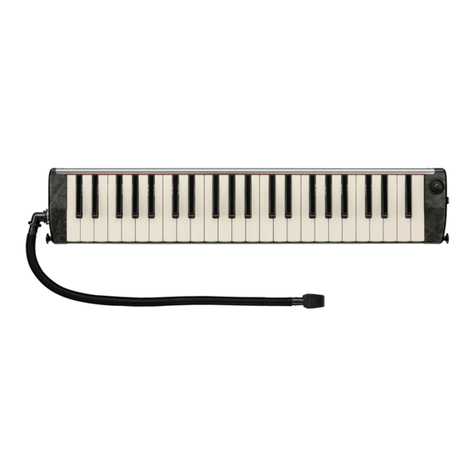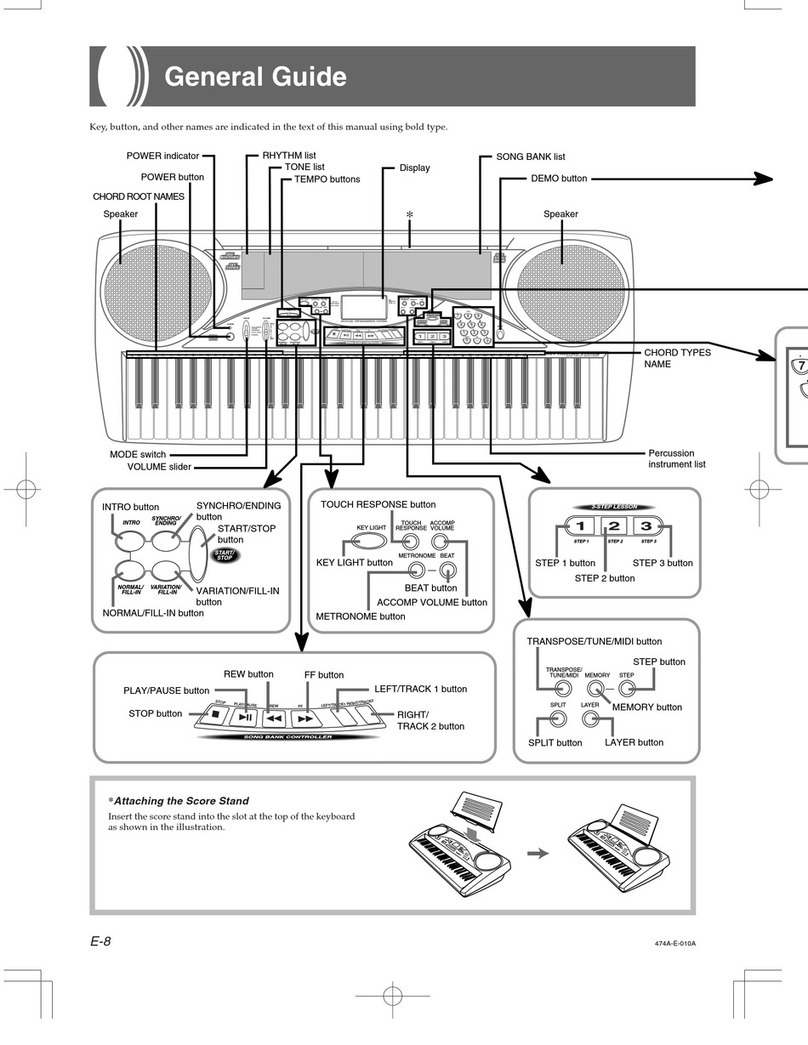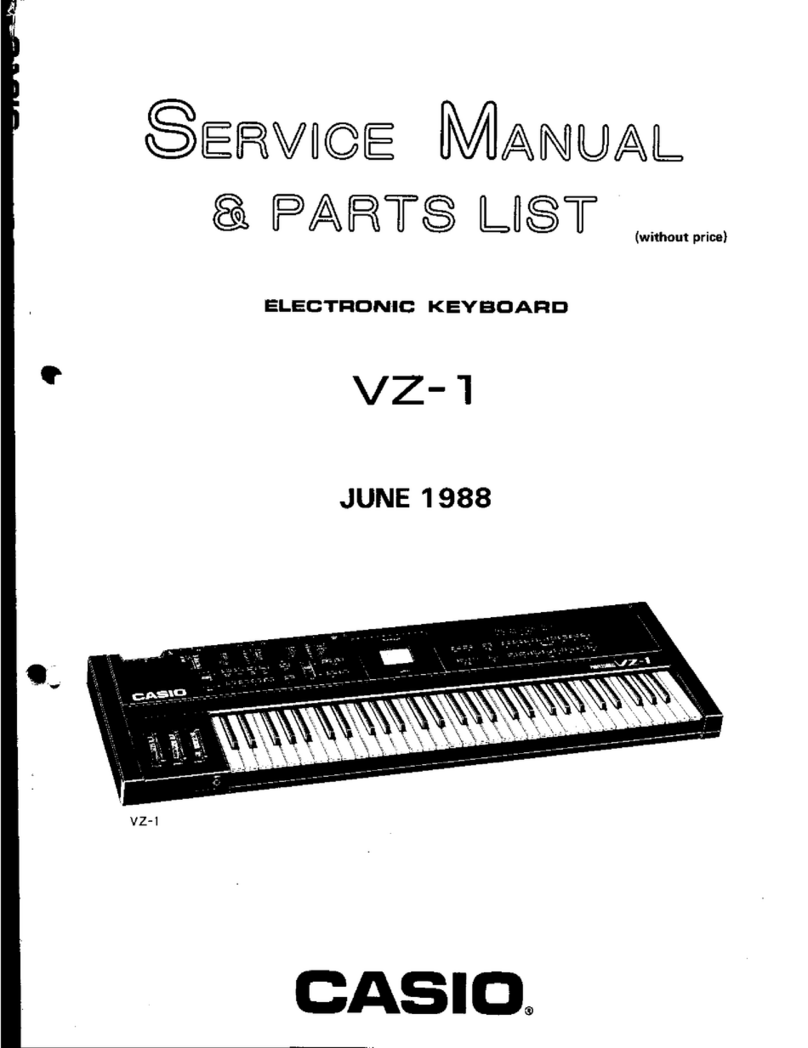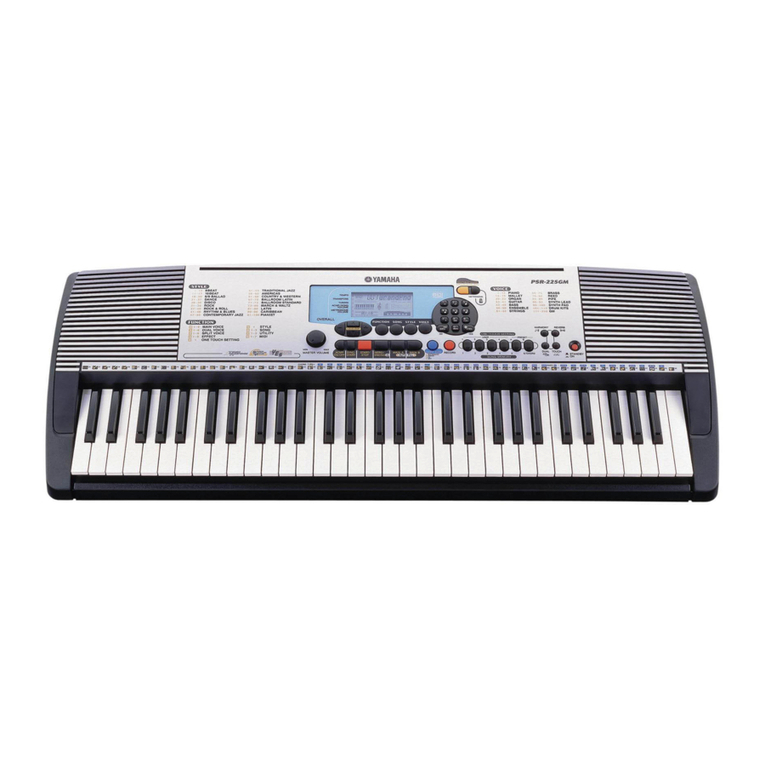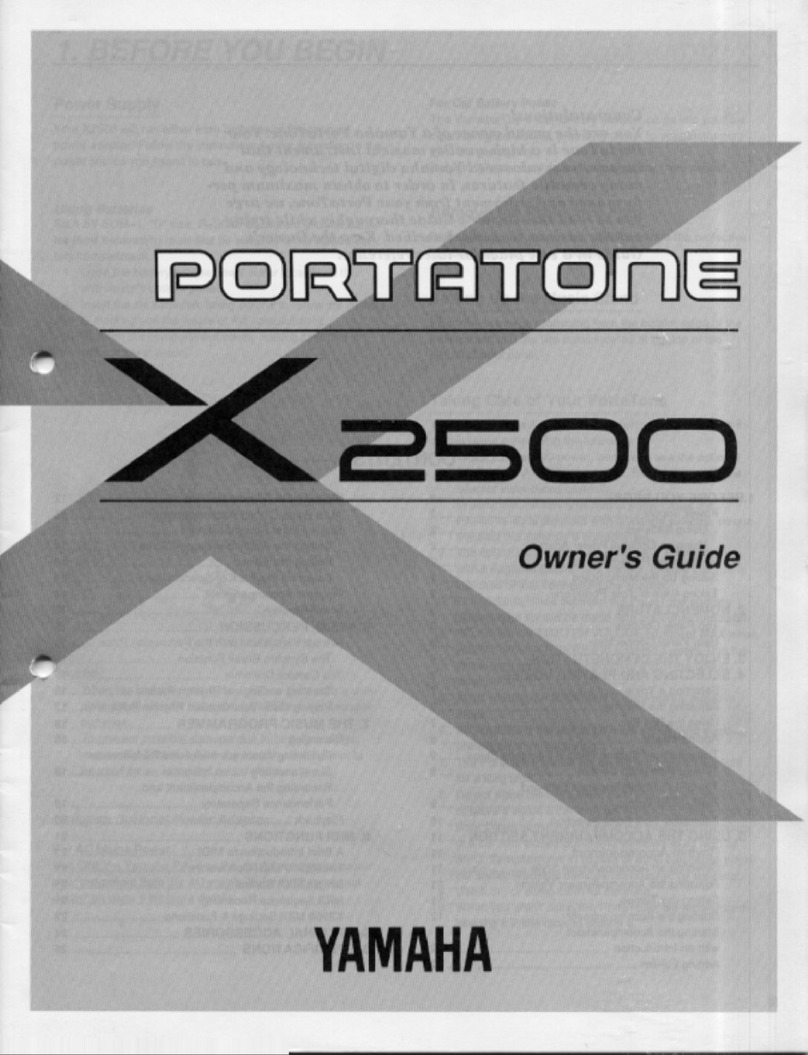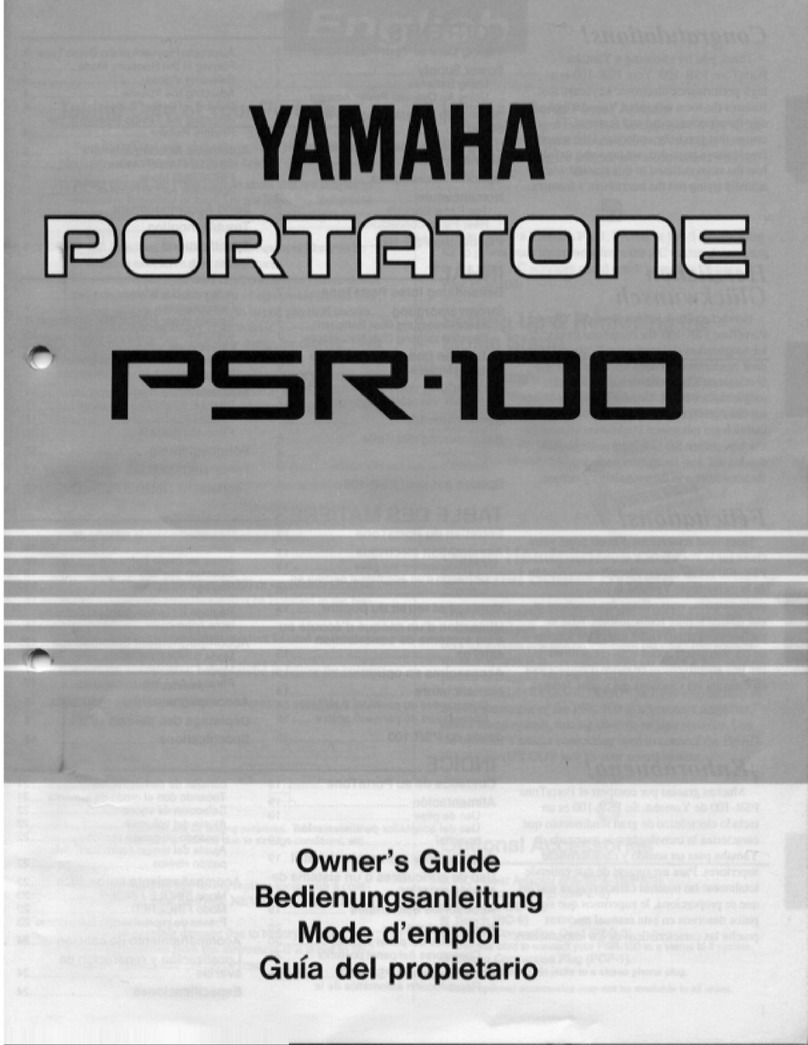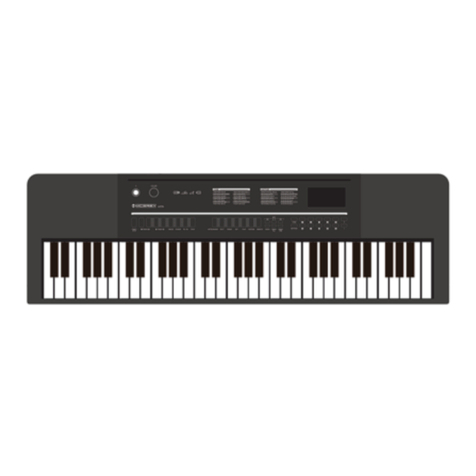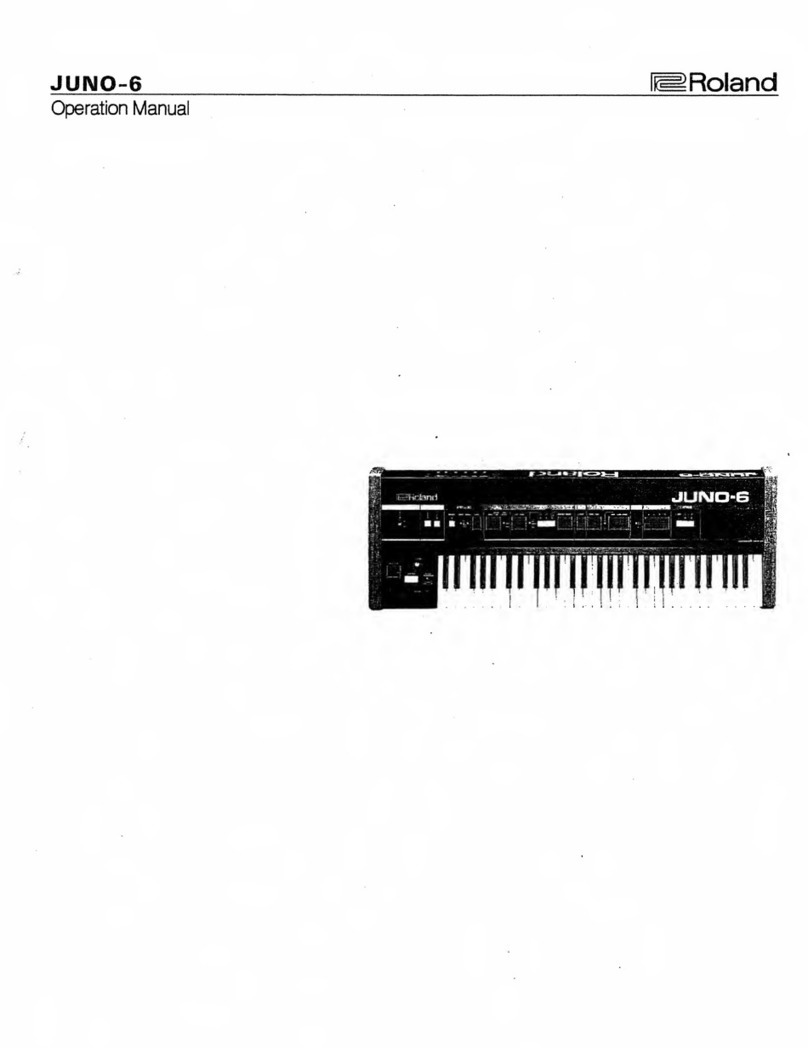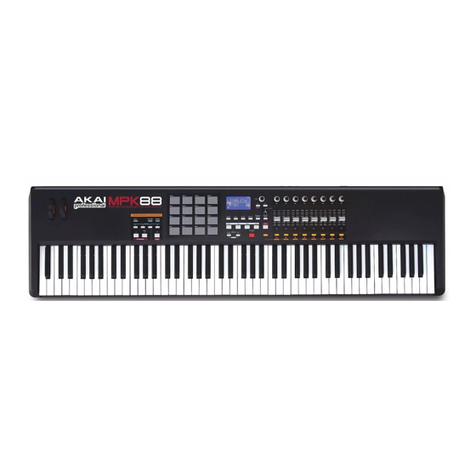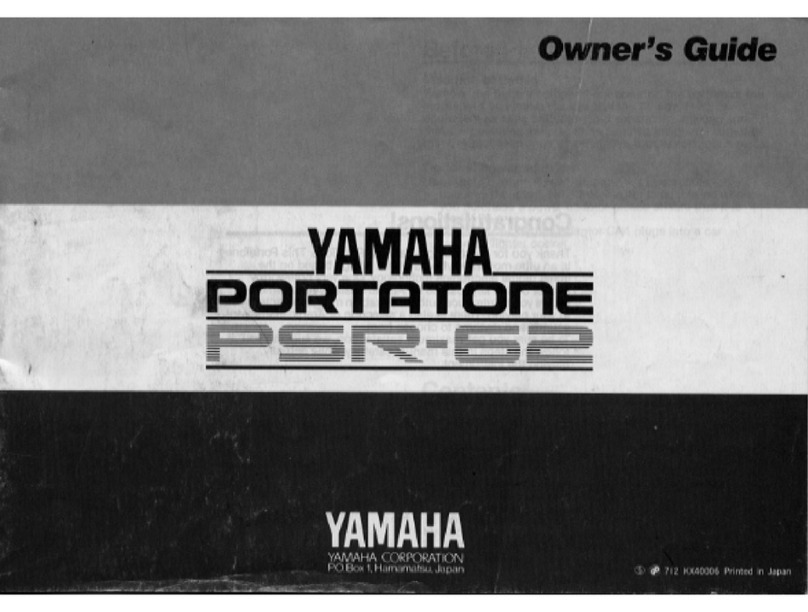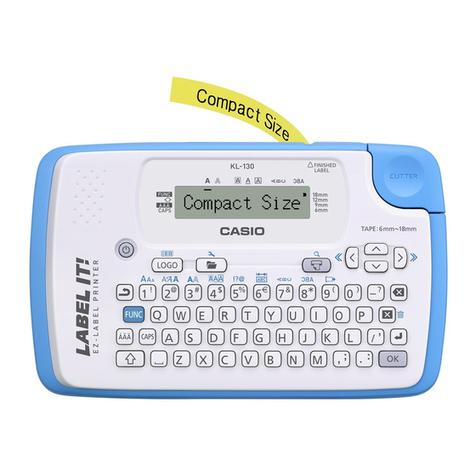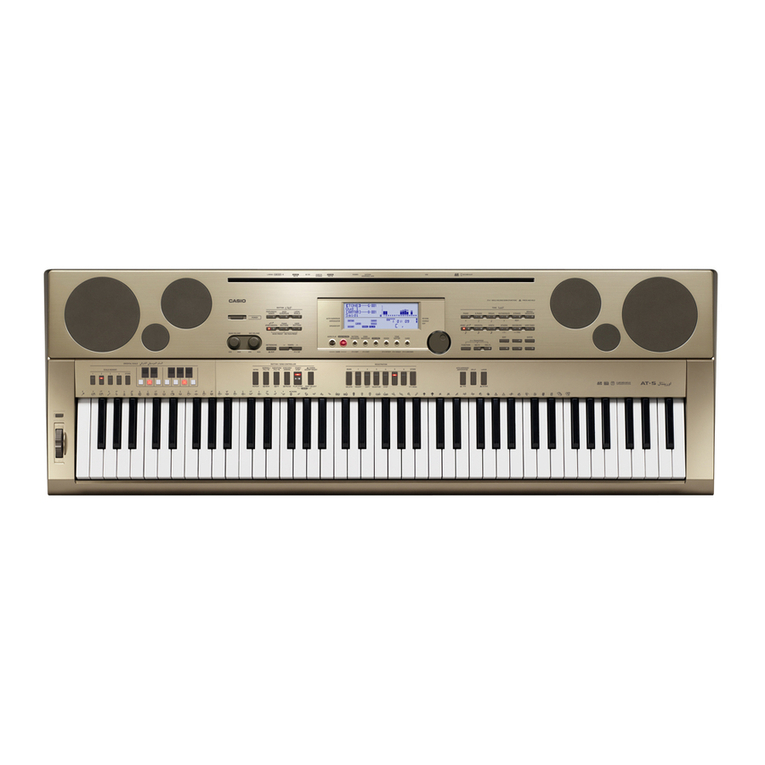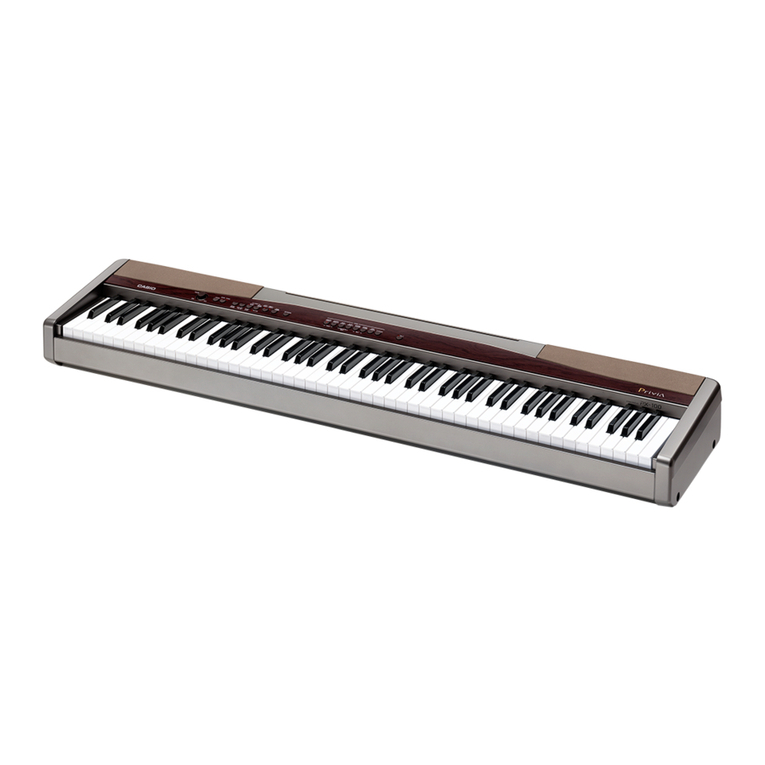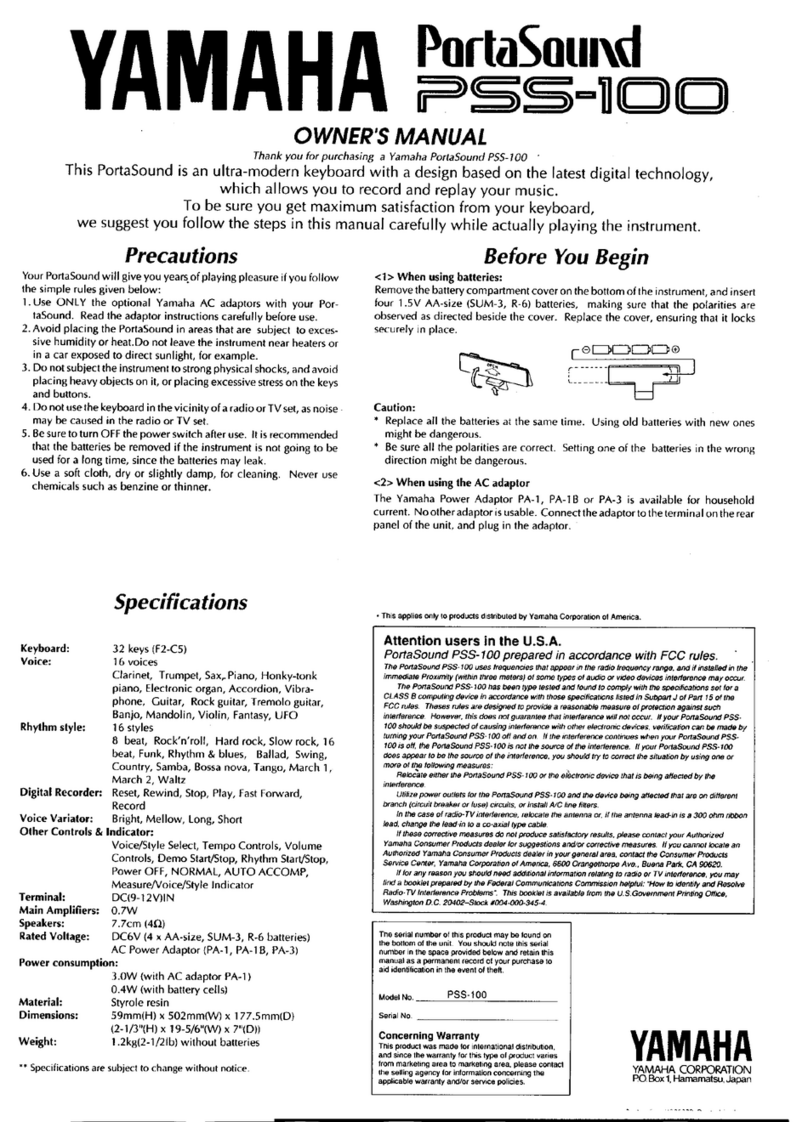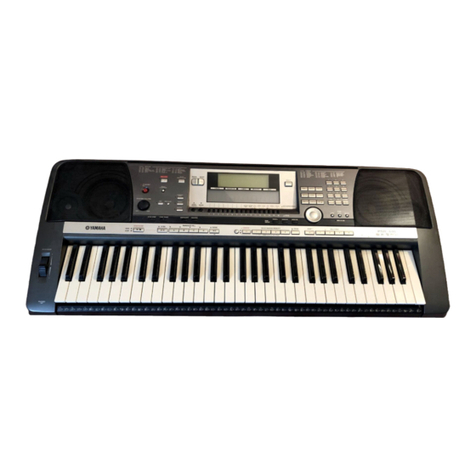Hammond XK-2 Quick Features Guide
- Table of Contents -
INTRODUCTION 1
Basic Hook-Up ............................................1
A.C. Power ......................................1
Audio Connections ................................1
Connecting to an Amplifier .................1
Connecting a Leslie Speaker ................2
MIDI Connections ................................2
Connecting a Foot Switch ...........................2
Connecting an Expression Pedal ......................2
Connecting the Hammond EXP-100 Expression Pedal .......3
Connecting a Set of Headphones ......................3
Basic Controls .............................................4
ON / OFF Power Switch .............................4
Information Center Display ..........................4
Touch Buttons ...................................4
Select Touch Buttons .....................4
Touch and Hold Touch Buttons .............4
Rotary Controls ..................................4
MASTER VOLUME Control .................5
REVERB Control ........................5
OVERDRIVE Control .....................5
BASS and TREBLE Tone Controls ............5
Pitch Bend and Modulation Wheels ....................5
INFORMATION CENTER DISPLAY 6
Play Mode ...............................................6
Graphic Display ..................................6
Numeric Display .................................6
Menu Mode ..............................................7
EDIT Touch Button ...............................7
Preset Parameters .......................7
Global Parameters .......................7
DRAWBAR SELECT Touch Buttons ..............................8
Drawbar Registration ..............................9
DRAWBARS 10
Sound Groups ...........................................10
Color Groups ............................................11
White Drawbars .................................11
Black Drawbars .................................11
Brown Drawbars ................................12
Tone Families By Shape ....................................12
Flute family ....................................13
Reed family ....................................13
Diapason family .................................14
String family ...................................14
Drawbar Volume ................................15
Drawbar Attack .................................16
Drawbar Sustain ................................17
Drawbar Voice Mode .............................18
Drawbar Fold Back ...............................19
Percussion ..............................................20
SECOND ......................................20
THIRD .......................................20
FAST .........................................20
SOFT .........................................20
Percussion Slow Decay ............................21
Percussion Fast Decay ............................22
Percussion Normal Level ..........................23
Percussion Soft Level .............................24
Percussion Touch ...............................25
Percussion Velocity Sensitivity .......................26
Percussion Drawbar Cancel .........................27
Percussion Drawbar Level ..........................28
Percussion Key Tracking ...........................29
MANUAL SPLIT 30
Upper and Lower Manuals on the XK-2 ..........................30
SPLIT Touch Button .......................................30
Advanced Features - Manual Split ..............................31
Split Point .....................................31
Changing the Split Point using the Value Touch
Buttons ....................31
Changing the Split Point by Key Input ........31
Split Mode .....................................32
Lower Manual Octave .............................33
EFFECTS 34
Vibrato .................................................34
V1 - (Small Vibrato) ..............................34
V2 - (Wide Vibrato) ..............................34
V3 - (Full Vibrato) ...............................34
Chorus .................................................34
C1 - (Small Chorus) ..............................34
C2 - (Wide Chorus) ..............................34
C3 - (Full Chorus) ...............................35
Speed ........................................35
Leslie ..................................................36
Leslie Touch Buttons .............................36
ON Touch Button ......................36
FAST Touch Button .....................36
BRAKE Touch Button ....................36
Leslie Parameters ................................37
Leslie Brake Time ......................42
Leslie Volume Balance ...................43
Leslie Microphone Setting ................44
Leslie Percussion Setting .................45
Using a Leslie Speaker Cabinet ......................46
Reverb .................................................47
Reverb Mode ...................................47
Reverb Level ...................................48
Overdrive ...............................................48
Overdrive Level .................................49
Treble Level .............................................50
Oscillator Phase Control .....................................51
PRESETS 52
CANCEL Mode ...........................................52
Preset Banks ............................................52
Recording Your Own Presets .................................53
MIDI 54
MIDI Connections .........................................54
MIDI IN and MIDI OUT ...........................54
MIDI THRU ....................................54
Typical Applications ........................................55
MIDI Channels ...........................................56
Omni Mode .............................................58
Local Control ............................................59
NRPN ..................................................60
Foot Switch Controller Number ...............................61
Modulation Wheel Controller Number ..........................62
Program Change ..........................................65
Drawbar Change ..........................................66
Control Change ...........................................67
Transmit Bender Data ON / OFF ...............................68
Transmit Modulation Wheel Data ON / OFF .......................69
Receive Breath Controller Data ON / OFF .........................70
Receive After Touch Data ON / OFF .............................71
Maximum Volume ........................................72
Minimum Volume ........................................73
Receive Transpose ON / OFF .................................74
SOFT THRU ON/OFF .......................................75
External Zones ...........................................76
MIDI Channels .................................76
Program Number ................................77
Program Bank ..................................78
Key Map ......................................79
Key Octave .....................................80
Maximum Volume ...............................81
Minimum Volume ...............................82
Velocity Curve ..................................83
Bender .......................................84
Modulation ....................................85
Damper ......................................86
MIDI Implementation Chart .................................87
MIDI Implementation - Each Channel ..........................88
Drawbar MIDI Data ........................................89
System Exclusive Messages ..................................89
SPECIAL ADVANCED FEATURES 90
Bend Length ............................................90
Modulation Mode .........................................91
Organ Zone Key Map .......................................92
Master Tune .............................................93
Tune Mode .............................................94
Transpose ..............................................95
Foot Switch Function .......................................96
Foot Switch Press "ON"/Press "OFF" ............................97
Foot Switch Alternate/Momentary ..............................98
SPECIAL UTILITY FEATURES 99
Memory Dump - All Data ...................................99
Memory Dump - Current Settings ............................. 100
Preset Copy ............................................101
Preset Back to Default ..................................... 102
Reset Procedure .........................................103
Quick All Reset Procedure .........................103
Expression Monitor .......................................104
Demo Songs ............................................105
Important Note - Battery ...................................106
Appendix A - System Parameter List ...........................108
Appendix B - Leslie Parameter (NRPN) List ...................... 108
Appendix C - Preset Parameter (NRPN) List ......................109
